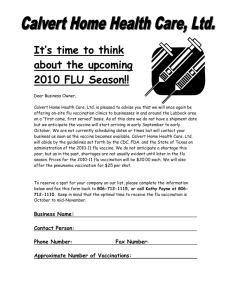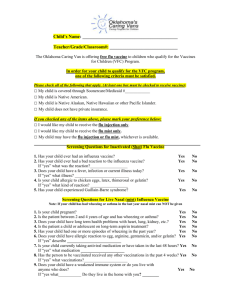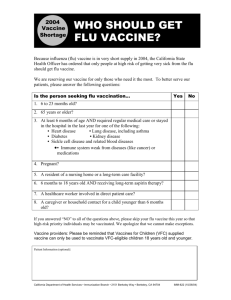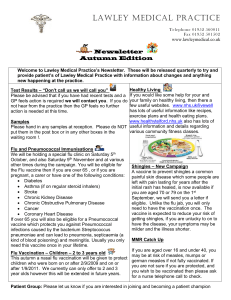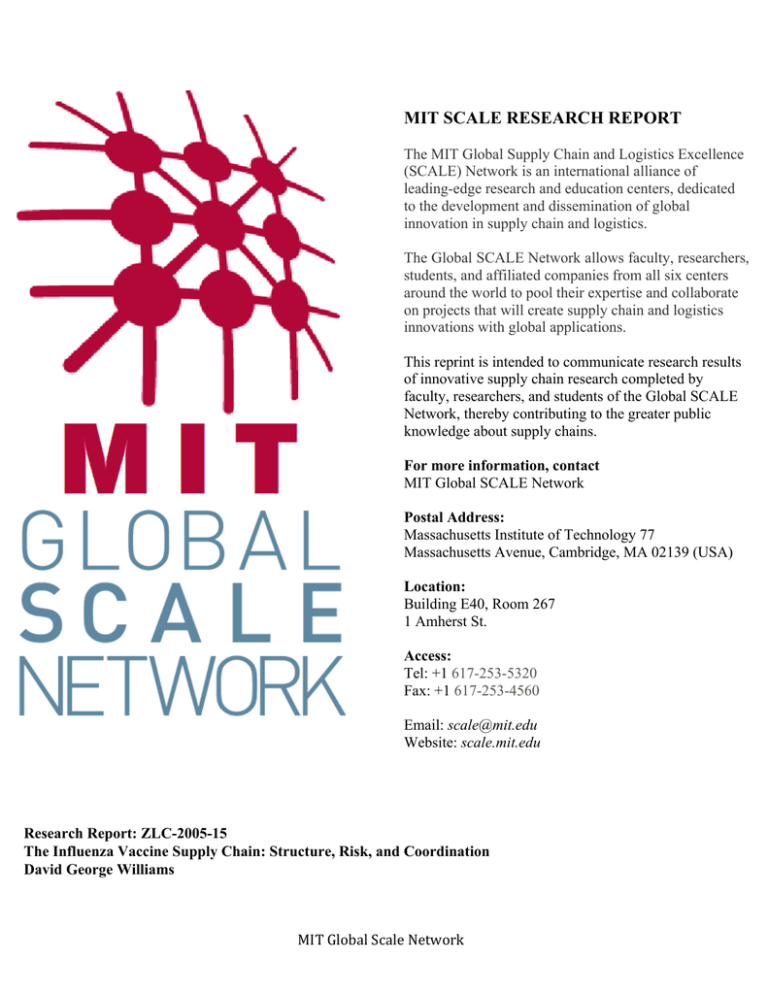
MIT SCALE RESEARCH REPORT
The MIT Global Supply Chain and Logistics Excellence
(SCALE) Network is an international alliance of
leading-edge research and education centers, dedicated
to the development and dissemination of global
innovation in supply chain and logistics.
The Global SCALE Network allows faculty, researchers,
students, and affiliated companies from all six centers
around the world to pool their expertise and collaborate
on projects that will create supply chain and logistics
innovations with global applications.
This reprint is intended to communicate research results
of innovative supply chain research completed by
faculty, researchers, and students of the Global SCALE
Network, thereby contributing to the greater public
knowledge about supply chains.
For more information, contact
MIT Global SCALE Network
Postal Address:
Massachusetts Institute of Technology 77
Massachusetts Avenue, Cambridge, MA 02139 (USA)
Location:
Building E40, Room 267
1 Amherst St.
Access:
Tel: +1 617-253-5320
Fax: +1 617-253-4560
Email: scale@mit.edu
Website: scale.mit.edu
Research Report: ZLC-2005-15
The Influenza Vaccine Supply Chain: Structure, Risk, and Coordination
David George Williams
MITGlobalScaleNetwork
For Full Thesis Version Please Contact:
Marta Romero
ZLOG Director
Zaragoza Logistics Center (ZLC) Edificio
Náyade 5, C/Bari 55 – PLAZA 50197
Zaragoza, SPAIN
Email: mromero@zlc.edu.es
Telephone: +34 976 077 605
MITGlobalScaleNetwork
The Influenza Vaccine Supply Chain:
Structure, Risk, and Coordination
By
David George Williams
In the
Massachusetts Institute of Technology – Zaragoza International Logistics Program
at the
Zaragoza Logistics Center, Zaragoza, Spain.
May 2005
© David George Williams
All rights reserved
Executive Summary
Over the last five years, the United States influenza vaccine supply chain saw both shortages of
vaccine at peak demand time and excess inventories after the influenza season had ended. There were
marked shortages of flu vaccine in 2000, 2003 and 2004 and between 4 and 15 million doses of flu vaccine
were wasted each year between 2000 and 2004. Because of a shortage mentality, health care providers may
have issued not only duplicate, but inflated orders to multiple distributors and manufacturers.
Accompanying this stress on the supply chain, there are problems in opportunistic vending; Chiron
corporation lost their entire 45 million units production in 2004, and within one week’s time, 80% of
hospitals were offered flu vaccine between $40 and $80 per shot, more than four times the original price of
$8 per shot, and 20% were offered vaccine at $80 per shot or more. This has led to a loss of between $200
and $500 million for manufacturers and health care providers. We posit if there are better ways to
coordinate this supply chain?
We interviewed industry professionals and government officials, surveyed physicians and queried
electronic databases. We reviewed the literature on the influenza vaccine supply chain, on supply chain
coordination, and on the economic value of flu vaccination. We identify the three main sources of
uncertainty in the supply chain as production yield uncertainty, demand uncertainty and uncertainty in the
severity and onset timing of the flu season which compounds demand uncertainty. We determine who
currently bears these risks. We conclude that in the influenza vaccine supply chain there are unextracted
profits for all parties involved. Rates of mortality are highest amongst the groups that are of high priority
for vaccination. Insurers and the public are at the greatest financial loss on the order of billions.
We use a simplistic model to illustrate why it may be profitable for insurers to buyback excess units
of flu from health care providers, combined with the industry wide use an Information-Hub. We formalize
this model into a contract we call a “buyback with prerequisites.” Through a numerical example, we
illustrate how this could increase every supply chain member’s profits. We comment on other initiatives
such as investing in new production technologies, the merits of using an information-hub alone, improving
incentives to prebook, a secondary market for reallocation efficiency, and universal vaccination.
1 The Position of this Work in the Literature
This paper aims to do several things which can be described as falling into three major categories,
identifying the structure of the US flu vaccine supply chain, consolidating relevant sources of data,
aggregating the various siloed viewpoints and opinions from many tiers of the supply chain, and offering
analysis with the aim of supply chain coordination.
First, we identify and map the current structure of the flu vaccine supply. This includes identifying
risks and uncertainties in the supply chain, how these risks are allocated, and the timelines that govern
forecasting, production, procurement, and risk transfer. Second, we aggregate the available data regarding
vaccination efficacy, patterns in production and waste, and the views of the government, the flu vaccine
industry, health care providers and to some extent, the public. Third, we postulate how risk in the supply
chain can be more logically allocated to reduce the effects of moral hazard and to bring about better
coordination, which in this case, means higher profitability for all parties and higher vaccination rates.
2 The Problems
We highlight some of the key problem areas in the flu vaccine supply chain.
2.1 Problems in Supply and Distribution
For the 2004-5 flu season, production capacity of 100 million doses was established, split equally between
the two suppliers of US flu vaccine, Chiron Corporation and Aventis Pasteur (now Sanofi Pasteur). On
November 7, 2004, Chiron Corporation, one of the two manufacturers of injectible flu vaccine for the US,
announced that because of contamination in its Speke, Liverpool facility, it was prevented from releasing
any of its flu vaccine for the 2004-5 flu season. This reduced the U.S. vaccine supply by nearly half, from
100 million to 55 million.
The CDC planned an emergency redistribution of flu vaccine with the only remaining supplier,
Aventis. Meanwhile all over the U.S, panicked elderly began demanding flu vaccine. Opportunistic
vendors began actively soliciting hospitals, offering doses of vaccine at steep margins. Price gouging
lawsuits began in several states. The candidates in the 2004 presidential election became involved, each
creatively placing the blame for the vaccine shortage on the other’s political camp. Finally, now five
months after the CDC’s emergency rationing and redistribution scheme, there is ironically a significant
unused surplus of about 4 million units and Aventis potentially faces tens of millions in lost revenue.
The worst example of opportunistic vending in times of shortage was exposed in a 2003
Washington Post article; during the flu vaccine shortage of the 2000-01 flu season, a New Jersey
wholesaler bought discounted vaccine intended for nursing home patients, promising not to resell the drug.
They violated that contract and within 11 days, the units of vaccine had changed hands 3 times, going from
$23.65 in New Jersey to $147 in Pittsburgh.
2.2 Problems in Demand
Demand for flu vaccine is largely a function of perceived necessity and the current public perception
is that flu vaccine is “unsafe and ineffective” (Dorland Healthcare 2004). Because of these biases and a
misconception of until when vaccination has efficacy, overall demand is low even though the medical
literature consistently shows that flu vaccination is cost effective and substantially reduces illness. It may
be the case that people who should rationally get a flu shot do not; some people would pay less for a shot
than they expect to pay in missed work or for medication. This is either a case of irrationality or bounded
rationality.
There is also a problem with the public perception of when vaccination is efficacious. Through
discussion with the CDC, we learned that vaccination has utility through at least January. However, many
Americans believe that the only useful time to be vaccinated is at or before Thanksgiving (late November).
2.3 The Decision Problems
We discuss the decision problems faced by manufacturers and health care providers in some detail. Each
year, manufacturers ask “how much vaccine should be made?” [The lot sizing problem] while contending
with demand uncertainty and yield uncertainty. Because of the uncertainties, manufacturers have to
allocate extra capacity, some to buffer against production uncertainties, and some to make vaccine to stock
for late ordering and changes in already placed orders. Furthermore health care providers will face two
complicated problems regarding influenza vaccination, namely: how many units should be procured at
what time and from which supplier [the procurement problem] and given the current state of supply and
demand, who should be given priority for vaccination? [The priority problem]
2.4 Unique Challenges in the Flu Vaccine Supply Chain
The flu vaccine supply chain poses unique challenges for several reasons:
Six to nine month lead time culminates in a one to two month selling season:
Manufacturing has to begin after the Center for Disease Control and the World Health Organization
identify the dominant three strains for the coming flu season, 7 to 11 months in advance. This
identification has been successful in nine out of the last ten years. Following strain identification, egg
based production takes up to nine months from start to finish. The vaccine must be shipped and store in a
“cold chain,” or a refrigerated supply chain which adds to the holding cost. All of this implies that health
care providers have to forecast demand up to 9 months in advance. The flu season is short enough that
manufacturing cannot be staggered and emergency production is not currently possible.
Unused vaccine discarded at the end of the season:
The three virus strain mix must be reengineered every year. The previous year’s vaccine cannot be used.
Flu vaccine is medicine sold to healthy people:
Demand must be generated through public awareness. Demand is sensitive to perceptions.
Vaccination business is not largely profitable for health care providers; misalignment of incentives and
responsibilities.
Flu vaccination is more a public service than a private enterprise; profit margins may be low as evidenced
from our survey of health care professionals. There is no salvage value for overstock and goodwill loss
from understock is unclear. Health care providers do not bear the risk for poor forecasting; they do not
have a financial incentive for making sure the high risk patients are vaccinated, other than the lost profit
margin. Their main incentive is the Hippocratic Oath, appealing to doctor’s good nature. (Compare with
insurance companies who may have to pay one or two orders of magnitude the cost if an elderly person gets
sick because of the did not get vaccinated)
Tension between pre-booking and regular booking: yield uncertainty versus demand uncertainty:
The health care provider must choose between the benefit of a certain service level guarantee through prebooking even though it exposes them to the risk of demand uncertainty, and the benefit of waiting longer
into the season to order even though it exposes them to the risk of not getting units or getting them at a
higher price. The manufacturer must choose between the benefit of better planning through pre-booking
even though it exposes them to the risk of yield uncertainty, and the benefit of waiting longer into the
season to take orders (so that prices might reflect supply and demand more accurately) even though it
exposes them to the risk poor planning.
2.5 The Root of the Problem
The main source of all the troubles regarding the flu vaccine supply chain is a time consuming and
economically inefficient egg based production technology combined with public demand that is variable
and does not reflect a rational understanding of vaccine efficacy. The time to produce does not allow for
any slack in the system for distribution lead time buffering, nor does it allow for staggered production. The
erratic demand for influenza vaccine in the United States, which is irrationally low from a cost benefit
analysis, combined with the minimal efficient scale (MES) for egg based production, just barely make the
business profitable and do not allow for more than just a few manufacturers.
We comment on some initiatives to aid in these root problems. For example, the U.S.
government and the Crucell Corporation are investing in cell based technology which promises to reduce
lead times and yield uncertainty. The U.S. National Institutes of Health (NIH) granted $9.5 million to ID
Biomedical to develop their cell based technology. They are in early stage human trials for that new
influenza vaccine. Also, in January 2004, Aventis and Crucell created a partnership to produce influenza
vaccine using Crucell’s Per.C6 cell based technology. Their agreement covers production of vaccine for
both the epidemic and pandemic flu vaccines.
In short, cell based production technology is said to offer the following improvements over egg
based production:
1. A production process with lower variation.
2. A lower cost per unit (excluding R&D costs)
3. A shorter lead time on the order of weeks.
4. An improvement in quality compared to existing vaccines
a. No need for mercury to prevent against salmonella infection of eggs. The use of
Thimerosal aggravates the public’s mistrust of the vaccine.
b. No potentially allergenic animal protein additives.
5. Finally, Crucell would be able to produce vaccines against some of the most virulent strains of
influenza which in some cases are difficult using egg based technologies.
a. Many strains of influenza come from water fowl. An extremely virulent strain will have
an increased ability to kill fowl and destroy bird eggs, making the standard chicken egg
production difficult. The potential pandemic strain H5N1 fits into this category.
The main focus of our work, however, is toward supply chain coordination given the current difficulties.
3 Toward Coordination: The “Buyback with Prerequisites”
and an Information hub
It may be profitable for insurance companies to offer a buyback of excess vaccine inventory from health
care providers. Increasing the stocking quantity at the health care provider may lead to savings by reducing
the number of more serious return visits. We are intrigued by the idea of combining such a buyback with
the use of an information-hub “that instantly processes and forwards relevant information to all appropriate
parties. The information hub is a node in [a] data network where multiple organizations interact in [the]
pursuit of supply chain integration. It has the capabilities of data storage [and] information processing. The
overall network forms a hub-and-spoke system with the participants' internal information systems…” (Lee
and Whang 2001) We also comment on the value of adopting an information- hub in the flu vaccine supply
chain even without a buyback.
Because of the Federal Emergency Medical Treatment and Active Labor Act (EMTALA), people
who become so ill, for example with the flu, so as to warrant visiting the emergency room, must be treated
regardless of insurance status. Health care providers will most likely pass these costs onto the insurers in
the form of higher treatment costs. Such treatment can cost between $142 for those directly discharged
from the emergency department, and $3,250 for those who must be hospitalized.
Thus it is in the best interest of the insurers to stabilize demand for the vaccine for those who are
statistically most at risk. Because a buyback would bring about a higher stocking quantity at the health care
provider we conclude that as long as we can encourage good forecasting and honest forecast sharing
throughout the supply chain, insurance companies will likely see increased profits as fewer people trickle in
to the health care provider with flu. (We stress that we only recommend Pareto dominant initiatives and
that we are not recommending altruism on the part of any party involved in this supply chain.)
In our future vision of a flu vaccine supply chain information-hub, health care providers,
distributors and manufactures would all have accounts to keep track of who ordered what amount of flu
vaccine from whom and when that order was placed. In an ideal world, with completely digitized medical
records, health care providers would submit an order with a marker for which patient that order was
intended for; this would eliminate the order gaming problem. Even though this is many years from reality,
it may be reasonable to assume that large, capital intensive facilities have the capabilities to participate in
such a system. Our buyback with prerequisites consists of five steps:
1. The CDC and the NIH collaborate closely with insurers to standardize what groups should be
considered as high priority for vaccination. The CDC and NIH have a scientific understanding of the
spreading of influenza communication, and the insurers have a unique perspective on reimbursement
costs and trends; the combination of both perspectives may lead to new insights.
2.
Insurers offer a buyback of excess flu vaccine inventory from health care providers under the
following conditions:
a. Health care providers generate a report of their (as defined above) high priority patients and
share that report with insurers.
b. Insurers offer to buyback excess flu vaccine that was intended for those high priority patients
in the report.
c. Insurance Companies, Manufacturers and the CDC create an information-hub through which
health care providers would be obligated to order.
We can compare the initiatives with their benefits:
Initiative
The CDC and the NIH collaborate closely with
insurers to standardize what groups should be
considered as high priority for vaccination.
Insurers offer a buyback of excess flu vaccine
inventory from health care providers.
Health care providers generate a report of their (as
defined above) high priority patients and share that
report with insurers.
Insurers offer to buyback excess flu vaccine that
was intended for those high priority patients in the
report.
Insurance Companies, Manufacturers and the CDC
create an information-hub through which health care
providers would be obligated to order.
Benefits
The CDC and NIH have a scientific understanding
of the spreading of influenza communication, and
the insurers have a unique perspective on
reimbursement costs and trends; the combination of
both perspectives may lead to new insights.
This would increase the order quantity at the health
care provider, increasing the vaccination service
level.
This will improve forecasts at the health care
provider. The buyback acts as an incentive.
This restricts the buyback and leads to forecast
revelation in the supply chain.
This will create more reallocation efficiency and
make health care provider’s forecasts transparent,
thereby removing the order gaming problem.
We are calling this type of buyback, a “buyback with prerequisites.” In essence it is a type of buyback
determined by a prerequisite exchange of information.
Figure 1: The “Buyback with Prerequisites” and an E-Hub
The adoption of the information-hub has several merits. With regard to pandemic preparedness,
the United States Human Health Services (HHS) states as the fifth element of the Phase 0, level 0 – Interpandemic phase: “Determine size of priority groups and develop a plan for vaccinating them (For example,
will hospitals be responsible for vaccinating their staff, and who will vaccinate those responsible for
community safety?).” The adoption of the information-hub for use in the standard acquisition of flu vaccine
could include a design that aggregates this data for the government while paying for itself.
The manufacturer benefits from more accurate advance planning since under this scheme, all units
would be prebooked, and the prebooked units would be made through the information-hub. The insurer
benefits further from the formation of a reliable dataset of the trends in high risk group vaccination. The
information-hub eliminates the multiple and inflated ordering problem because of order transparency.
Also, the information-hub generates reallocative efficiency as there would be a log kept of where unit of flu
vaccine have been shipped and received.
In terms of market reallocative efficiency and redistribution efforts, the information-hub would
serve as a secondary market, where health care providers and distributors would order directly from other
health care providers and distributors who wish to sell excess. Then well established reverse logistics
providers, for example Fed-Ex or UPS, could directly handle redistribution and reallocation with
comparative ease, cost advantage, and internal to the market economic efficiency, over the U.S.
Government.
Ordering through an information-hub would also aid in the health care provider’s decision
problems. Most worthwhile to note is that it alleviates the confusion caused by opportunistic profiteering
in times of shortage; secondary distributors often invest in strategic inventories of crucial or highly
demanded medications to sell in times of shortage and burden health care providers with repeated emails
and faxes promising vaccine availability, albeit at a steep margin. With such repeated solicitations, health
care providers will have a difficult time knowing the extent of the shortage, and if the pressures of shortage
have subsided. This leads to suboptimal decision making because of information distortion. The
information-hub helps this issue by making wholesaler’s inventories, manufacturer’s inventories, and
health care provider orders transparent to all relevant parties. Not only would this be more ethical, but
potentially profitable, as health care providers can make closer to optimal decisions and manufacturers and
credible wholesalers can receive faithful demand data, and clearly display their inventories for purchase.
3.1.1 A Simple Experiment
Under some reasonable assumptions, we give a numerical illustration of our buyback with
prerequisites:
ORDER QUANTITY
HIGH RISK
VACCINATED
COST TO THE
INSURER
MANUFACTURER’S
PROFIT
HEALTH CARE
PROVIDER’S
PROFIT
BEFORE THE
BUYBACK
88
42
AFTER THE
BUYBACK
96
45
$903
NET CHANGE
8
3
+9%
+7%
$617
-$286
-32%
$175
$192
$17
+10%
$126
$145
$19
+15%
Figure 2: A Numerical Experiment
4 Conclusion
In the flu vaccine industry, demand leads supply. Supply is threatened by uncertainty in demand,
demand rates that do not reflect the true utility of flu vaccination, uncertainty in the onset and severity of
each flu season, and a rational under ordering phenomenon by health care providers. Long lead times
aggravate the problem; health care providers have to forecast patient demand long in advance. This all
stems from the antiquated egg based production technology that is so time consumptive and inefficient that
the time to produce does not allow for any “slack” in the system for distribution lead time buffering, nor
does it allow for staggered production. The minimal efficient scale (MES) of production in the eggs is such
that demand for influenza vaccine in the United States, which is irrationally low from a cost benefit
analysis, just barely makes the business profitable, while not allowing for more than a couple
manufacturers.
The structure of the health care reimbursement system in the U.S. is such that the two biggest
losers in the system are patients who cannot get vaccinated as they would like to be (or should be from a
rational standpoint) and insurance companies who have to reimburse health care providers for more serious
and expensive problems that develop as a result of low vaccination rates. Those who are not covered by
health insurance and who find themselves sick are covered by the EMTALA act of 1986 and health care
providers are likely to pass this cost on to insurers as well.
We studied several initiatives: First we proposed the notion of ordering through an informationhub mechanism to eliminate order gaming and aid in pandemic preparedness. Second we suggest a buyback
of excess flu vaccine at the health care provider by insurance companies with certain prerequisites that are
intended to encourage a Pareto Dominant solution to some of the current problems. We pointed to some
intuition as to why the buyback might help via a numerical illustration. The insurance company buyback as
we have modeled it is intended to do several things: First we hope such a model will serve as a source for
further investigation into richer and more applicable models. Second we hope that the measures used in the
model will help characterize policy performance and serve as a benchmark for which to base further
conversation. Such measures include high risk group vaccination rates, stocking quantities at the health
care providers, market allocative efficiency market reallocative efficiency, and supply chain profitability.
5 Future Research
Our work suggests several areas for research:
1.
To characterize the value of establishing a quick reverse collection and redistribution mechanism
and its impact on initial ordering and demand fulfillment along with practical suggestions for
implementing such a scheme.
2.
To develop a decision model for health care providers that supports optimal procurement policies.
3.
To further model the demand process for flu vaccine at each health care provider and to determine
the appropriate causal and correlated variables. This extends to identifying the time varying
correlation between the demand processes at different health care providers.
4.
To find data that supports item 3. It has been rumored that point of sales data for cold and flu
medicine at Wal-Mart has been well maintained and thus may be useful to this end.
5.
To clarify disparities in the economic valuation of vaccinating against flu.
6 References:
Lee Hau L., Whang, Seungjin, “E-Business and Supply Chain Integration,” Stanford Global Supply Chain
Management Forum, SGSCMF- W2-2001, November 2001, Stanford University.
Flaherty, Mary Pat, Gaul, Gilbert M. “Higher Prices, More Compromises,” The Washington
Post. Washington, D.C.: Oct 19, 2003. pg. A.16

